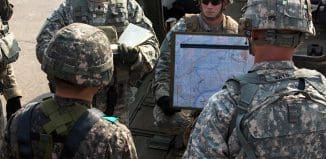The Ivory Curse: Poaching Funds Terror and Conflict
This post is also available in:  עברית (Hebrew)
עברית (Hebrew)

The fight against ivory poaching is fierce. At the headquarters of the Mara Elephant Project, Marc Goss contemplates a jumble of squiggly lines superimposed on a Google Earth map. Each line represents the recent movements of a GPS-collared elephant in the Maasai Mara National Reserve in Kenya. Generally, the animals move too slowly to notice.
Occasionally, however, Goss sees what he calls “a streak” – when one of the lines suddenly lurches forward. It means the animal is being chased by poachers. If the streak stops cold, Goss surmises that another elephant has just been killed.
According to New Scientist an unsustainable four elephants are killed in Africa every hour for the ivory in their tusks. But while impoverished locals are enlisted to pull the triggers, it is highly organized transnational crime syndicates and militias that run the poaching and reap the lion’s share of the profits, fuelling terrorism and increasingly war.
That’s the conclusion of a joint report by the conservation group Born Free USA and C4ADS, a non-profit organisation that conducts data-driven analysis of security and conflict issues.
Varun Vira, a senior analyst at C4ADS and one of the authors of the report, says it is the first study to look at the problem through the lens of conflict and national security rather than conservation. The report, titled Ivory’s Curse, draws on publicly available government data, news reports and interviews with government officials and conservationists.
iHLS – Israel Homeland Security
It paints a bleak picture of a slaughter which is disastrous not just for elephants, but for the stability of African nations, and claims that blood money from ivory has helped to bankroll almost every conflict in Africa in recent decades. “The modern ivory trade was built on war,” says Vira.
In 2013, roughly 400 tonnes of ivory was trafficked, representing the tusks of 50,000 elephants – a billion dollar a year business. The price of ivory in China, which is by far the largest market, has sky-rocketed from $6 a kilo in 1976 to $3000 today – far more than most Africans earn in a year.
The report identified seven regions where conflict and ivory trade are deeply connected, and shows that much of the poaching takes place across borders. For instance, the report builds on previous findings that Somali terror group al-Shabaab funds itself with money from tusks poached in northern Kenya, adding that the ongoing civil war in the Central African Republic (CAR) is being partly funded by ivory. Meanwhile, Nigeria’s Boko Haram is targeting elephants in Cameroon.
In Sudan, government-allied militias complicit in the Darfur genocide fund their operations by poaching elephants in Chad, Cameroon, the CAR and northern Democratic Republic of the Congo. South Sudan, which boasted 130,000 elephants 25 years ago, is down to just 5000 animals today due to poaching by both sides in the recent conflict.





























